
Protecting the world from disease
We’re combating emerging infectious diseases that pose the greatest threat – because healthier animals help make a healthier future for all.
This audio recording was enabled by AI
A cat in France is infected with a virus from ducks on a nearby pond. A dog with rabies delivers a lethal bite to a child in South India. Outbreaks of African Swine Fever stall pork trade between multiple countries. COVID-19 outbreaks shut down shipping ports, resulting in supply shortages around the world.
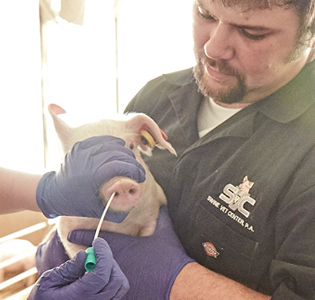
“Emerging infectious diseases in animals impact livestock, pets, humans, communities, economies and the planet,” said Mahesh Kumar, Ph.D., who leads Global Biologics Research & Development at Zoetis. “This interconnectivity means we must be vigilant. We must constantly monitor diseases, have research programs in place and respond quickly to a threat. Rare is an infectious animal disease we are not working on.”
How serious is the problem?
Emerging infectious diseases (EIDs) in animals include outbreaks of unknown diseases, increases of a known disease in a new or existing area, and infectious diseases that cannot be controlled.
EIDs can impact all types of animals, from great apes in zoos to playful puppies at the dog park, and from chickens in the henhouse to cattle in the pasture. Not only do animals suffer, but so do the people who care for and depend on them. Consider the statistics:
- Livestock production accounts for approximately 70% of income in the world’s poorest countries.1
- Diseases that jump from animals to humans, or zoonotic diseases like Ebola, monkeypox and COVID-19, have killed millions of people and made many others ill.2
- Rabies, which has been nearly eliminated in some countries, still claims nearly 60,000 lives each year, many of whom are children.3
Animal diseases also can impact the food supply. The global population is expected to grow from 7 to nearly 10 billion by 2050,4 triggering the need for more milk, meat, chicken and eggs to feed families and communities. If unchecked, animal diseases, such as Highly Pathogenic Avian Influenza in poultry and African Swine Fever in pigs, can wipe out entire flocks and herds.
Researchers and scientists with Zoetis’ Center for Transboundary and Emerging Diseases (CTED) are working hard to protect animals – and people – by combating the infectious diseases that pose the greatest threat to our world.
CTED: ‘First to know and fast to market’
Every day, CTED teams receive alerts from around the world about diseases that could mean trouble, like an outbreak of Bluetongue disease in sheep in the Netherlands or increasing cases of canine influenza in the U.S. Midwest. The Center works with leaders from government, health organizations, diagnostic laboratories, and the veterinary and livestock communities to track infectious disease threats.
“We have an extensive surveillance network. We monitor threats, assess them using our emerging infectious diseases scorecard and determine our response,” said John Hardham, Ph.D., CTED’s Research Director. “Based on the level of threat, we can mobilize resources quickly to help control and curb the outbreak with vaccines and diagnostics. We want to be first to know and fast to market.”
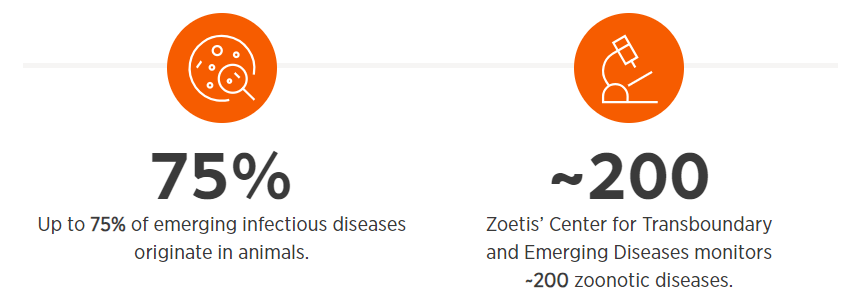
CTED currently monitors approximately 200 diseases identified by the World Health Organization as zoonotic.5 An estimated 60% of known infectious diseases and up to 75% of emerging infectious diseases originate in animals.6
“When veterinarians, livestock farmers and pet owners are faced with animal disease challenges, we want them to know we’re ready and here to help – because healthier animals make a healthier future for all,” said Dr. Hardham.
For the past several years, experts at CTED have been developing vaccines for high-impact emerging infectious diseases, including Foot and Mouth Disease, African Swine Fever and SARS-CoV-2 (the virus that causes COVID-19). Their extraordinary efforts have led them to some amazing places.
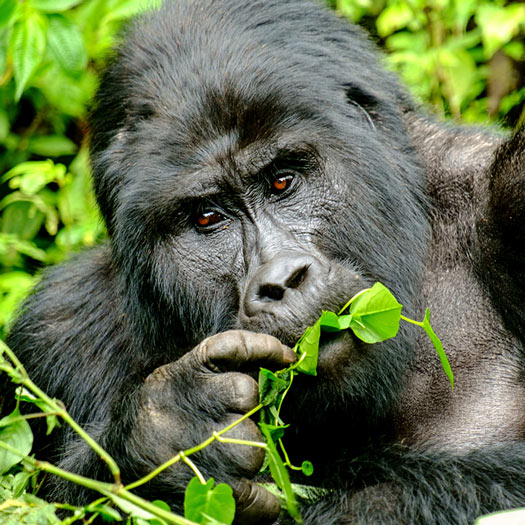
Protecting the great apes and other zoological animals
While COVID-19 infected humans in nearly every region of the planet, concerns began to surface about COVID-19 in pets when a dog tested positive for the virus in Hong Kong.7 Zoetis immediately began developing diagnostics and a new vaccine for potential use in dogs and cats.
“We already had a number of coronavirus vaccines on the market, such as those preventing strains that infect poultry, pigs and cattle,” said Dr. Hardham. “Because of our previous research with coronaviruses, we were able to complete the initial studies for a COVID-19 vaccine in dogs and cats within eight months.”
But the first request for the vaccine came from an unexpected source. “We got a call from the San Diego Zoo after eight gorillas tested positive for COVID-19. We donated experimental vaccines for the zoo’s emergency use, and the zoo vaccinated its great apes – gorillas, orangutans and bonobos.”8
Ultimately, the vaccine was used in over 300 species of animals in zoos around the world – a first in vaccine history.
Saving the endangered California Condors
Highly Pathogenic Avian Influenza (HPAI) is the most globally talked about disease threat for poultry, according to Greg Nitzel, who leads global poultry research for Zoetis. “HPAI is carried by migratory birds. The virus sheds as the birds fly and is transmitted to other birds on the ground, like those on chicken farms. Because migratory patterns have changed, we’re seeing HPAI in countries that have never reported it before. The virus is highly infectious and often fatal to chickens, turkeys and ducks.”
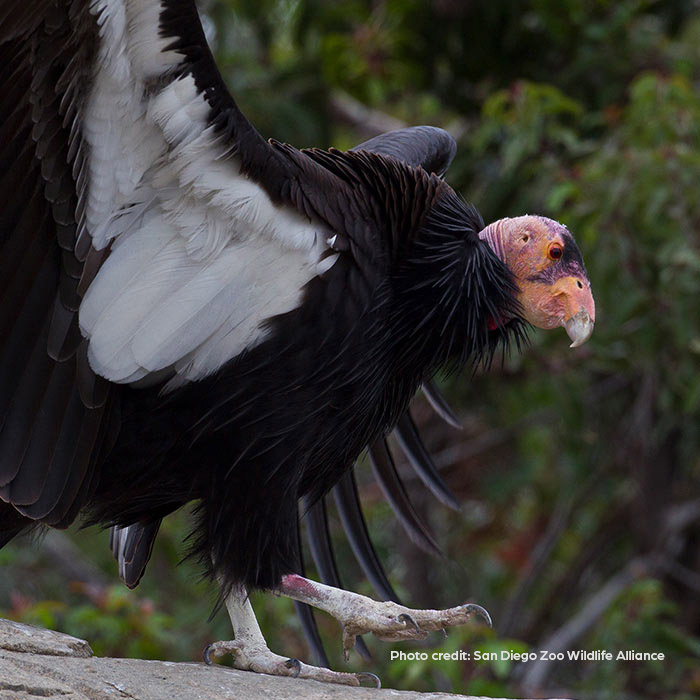
The disease also impacts birds, such as the critically endangered California Condors, one of the largest flying land birds in North America. Just over 500 exist,9 and when 20 of the magnificent birds died from HPAI in March 2023, the U.S. Department of Agriculture (USDA) reached out to Zoetis scientists for help at the request from the U.S. Fish and Wildlife Service (USFWS), the agency monitoring the condor situation.
“The USDA contacted us about the infections in the condors in April 2023, and within 48 hours, we had the approval and funding from Zoetis leadership to supply the HPAI vaccine we conditionally licensed in 2016 to support the initiative being led by the USFWS and USDA,” said Greg.
As an extra step of caution, the Zoetis vaccine was initially administered to the related black vulture species at the Carolina Raptor Center (CRC) in North Carolina to assess safety and immunological response. “The team confirmed that the vaccine delivered a strong serological response and was safe to use,” said Greg. “It was critical to demonstrate safety before delivering it to the endangered condors.”
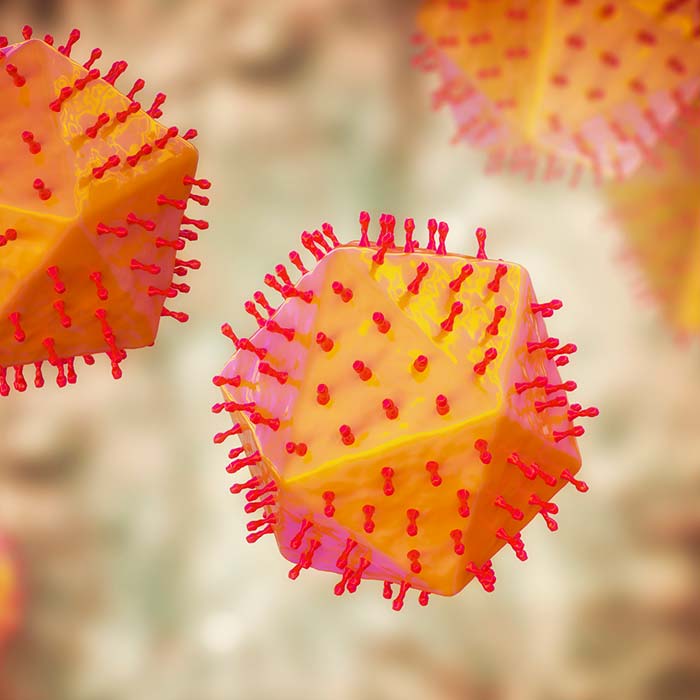
Stopping the steady march of African Swine Fever
For the past five years, Alicia Urniza has paid close attention to the spread of African Swine Fever (ASF). A real-time map shows the disease steadily marching from country to country, devastating pig herd after pig herd.
“Leading animal health organizations have listed African Swine Fever as one of the world’s major emerging animal infectious diseases,” said Alicia, who leads research and development for biologics at Zoetis’ Belgium and Spain operations. “The disease cannot be transmitted to humans, but it poses a huge risk for animals and food security. It can also jeopardize international trade.”
The earliest detected cases of ASF occurred in East Africa in the early 1900s. It later spread to European and Asian countries.10 The disease causes pigs to bleed, run a high fever and die.
“It’s not a new disease, but it has challenged researchers for decades,” said Alicia. “The virus is huge, complex with more than 170 polypeptides. Many of these viral proteins play a role in the virus evading the host immune response. Additionally, the correlation between humoral and cellular protection are poorly understood, which makes it extremely difficult to design a vaccine that is safe and efficacious.”
But scientists at Zoetis are not giving up. “We’re partnering with several of the most important ASF research groups to better understand ASF,” said Alicia. “We’ve also in-licensed vaccine candidates from the USDA Agricultural Research Service. Our aim is to control this disease with a safe and effective vaccine.”
‘New diseases lurking’
Dr. Kumar said infectious diseases will not go away anytime soon. “There will always be new diseases lurking, and we will continue to monitor and work to mitigate them – but we recognize we cannot do it alone. This is why we partner with labs across the world, universities, researchers and others to better understand emerging infectious diseases so we can prevent them from impacting farmers and pet owners.”
Despite the challenges of EIDs, Dr. Kumar said solving complex problems and developing innovative solutions are what Zoetis scientists and researchers work for every day. “We are a responsible animal health company doing the right thing for the right reasons. It makes me very proud that we are able to work on emerging infectious diseases and serve the greater good, which is what Zoetis’ purpose is all about: nurturing our world and humankind by advancing care for animals.”
Published on November 1, 2023
All trademarks are the property of Zoetis Services LLC or a related company or a licensor unless otherwise noted. © 2025 Zoetis Services LLC. All rights reserved.
References
1 Infographic-Why-does-animal-health-.jpg (2480×1772) (healthforanimals.org)
2 The costs and benefits of primary prevention of zoonotic pandemics - PMC (nih.gov)
3 Global Rabies Work | Stories & Features | NCEZID | CDC
4 World population projected to reach 9.8 billion in 2050, and 11.2 billion in 2100 | United Nations
5 Zoonoses (who.int)
6 The Global Governance of Emerging Zoonotic Diseases (cfr.org)
7 First great apes at U.S. zoo receive COVID-19 vaccine made for animals (nationalgeographic.com)
8 IBID
9 California Condor - American Bird Conservancy (abcbirds.org)
10 African Swine Fever Virus: A Global Concern (asm.org)